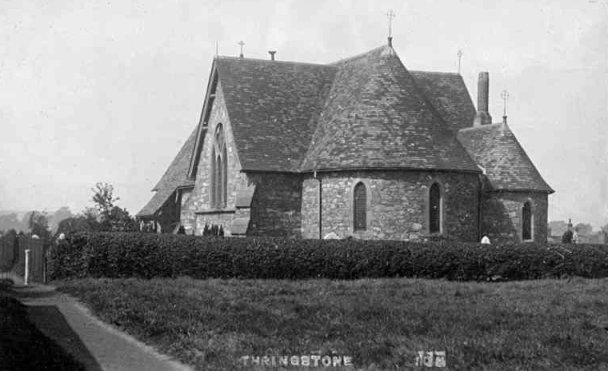
I am delighted to provide a foreword for this church guide. Stephen has spent years researching the church and its history and I am extremely grateful to him for doing so.
Over the six years I have been vicar, there have been many changes and I am especially proud of how the church now looks. It is a sacred space and through it's simplicity of design and architecture a building of beauty. It truly deserves its listed building status.
I hope you enjoy your visit to our church and find this guide helpful. If you would like to join us in worship, just ask for a newsletter and you will be made warmly welcome.
With God's blessing
Simon
May 3rd 2005
INTRODUCTION AND HISTORICAL BACKGROUND
The Parish Church of Saint Andrew, Thringstone is a small cruciform structure built in 1862 from the designs of James Piers StAubyn of London, the eminent Victorian church architect and restorer.
The plan is unusual, having a broad nave with shallow transepts, a round-ended sanctuary and a round-ended vestry on its north side.
The church was consecrated on Tuesday November 25 1862 and opened as a chapel of ease to Whitwick, there having been a great increase in population during the first part of the nineteenth century owing to the rapid expansion of the local coal mining industry.
Building work was carried out by William Beckworth of Whitwick and Mr Elliott of Ashby-de-la-Zouch/Burton at a cost of �750 12s.
Funding came from grants and public subscription, zealously elicited by the Revd Francis Merewether, Vicar of Whitwick. Mr Merewether, a theologian of decidedly �low church� views, preached and wrote prolifically against Ambrose de Lisle�s Roman Catholic mission, and was incensed by such developments as the founding of a Cistercian monastery within his parish and the opening of a Catholic day school at Turry Log, within the township of Thringstone, in 1843. It could be argued that the church at Thringstone owes the fact of its existence just as much to Mr Merewethers� desire to counteract the papist revival as to any demographic changes.
Mr Merewether was the chief benefactor of Thringstone Church, along with Sir GH Beaumont, ninth Baronet of Coleorton Hall, each of whom donated �100.
Thringstone became an independent ecclesiastical parish on October 29 1875, since which time there have been seven incumbents.
The church is one of forty-two in the Patronage of Her Majesty the Queen (in Right of her Duchy of Lancaster).
In the year 2002, the building was given Grade Two Listed status, together with the tomb of Charles Booth, the great social reformer, which can be found on the north side of the church yard.

The church is approached by a footpath, connecting Main Street and Loughborough Road, which is flanked by a high stone wall, built during the winter of 1910-11.
The church is built of Charnwood Forest stone in the Early English style. The construction is of random walling, which is pointed on the outside and plastered internally. The walls and corner angles are enforced with buttresses with set-offs. The dressings are of sandstone from Hollington.
The foundation stone was laid on Tuesday, April 22 1862 by the Revd Francis Merewether, MA and can be found set in the easternmost corner buttress of the south transept, though this is badly weathered and now largely illegible.
The church has a plain tile roof on which, at the west end of the nave, there sits a small framed bell-cot. This is surmounted with a copper fleche and contains one small bell, which was recast in 1917.
The roof underwent a complete re-tiling in 1955-56, and the building was re-pointed in 1962.

The south porch was added to the church in 1911 in memory of the first vicar, Edwin Samuel Crane. Built also of local granite rubble, the porch has a moulded doorway with hood mould, and a coped gable with finial. Two small lancet windows are set in the side walls, and there is a small, unglazed lancet in the gable, above the doorway. The architect was Thomas I McCarthy of Coalville (who also designed Holy Cross Roman Catholic Church, Whitwick) and the cost was �116, more than half of which was donated by the family of Mrs Crane.
The porch contains two wooden benches, which were renovated and parts renewed in 1966 in memory of Samuel Crane, son of the first Vicar and a former organist. According to the late Mr JW Wilkins, these benches were fitted with backrests at the request of the Revd C Shrewsbury, just high enough to obscure the stonemason�s name, chiselled at the bottom of Mr Crane�s memorial plaque. The story goes that the vicar ordered this modification after growing somewhat tired of observations by amused onlookers that the plaque read: �O Come let us worship and fall down and kneel before the Lord, Our Maker �� O.Lindley� !
The wrought iron gates in the porch were fitted during the incumbency of the Revd Brian Matthews.
The roof is made of deal. It is of high pitch, the principals, of which there are eight, consisting of principal rafters, crossed braces and struts, bearing on stone corbels built in the walls. The transept roofs cross that of the nave and are of similar construction. The bell-cot is carried on the second principal of the roof from the west. Wind-braces between the principals stiffen the roofs.
The height to the plates is 14 feet, and to the apex of the roof 32 feet.
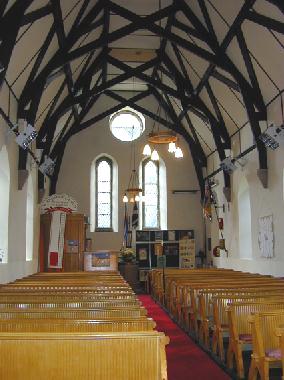
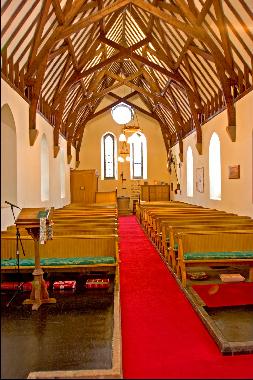
In 1952, the roof was boarded over internally (pictured above), leaving only the principal timbers open to the eye, with decorative beading in between.
Fifty one years later, the false ceiling was removed and the roof was restored to its former glory at a cost of approximately �80,000, in readiness for Easter Sunday, 2003.
NAVE
The nave measures 48 feet by 20, and has seven lancet windows on the sides, and at the west coupled lancets, with a circle over in the gable. Three of the side lancets contain stained glass by Kempe and Co, London, and the church became affiliated to The Kempe Society, Liverpool, in 2003
The bench pews are original fittings and were open-backed until being fitted with fluted hardboard by the Revd RF Willis and other volunteers in 1963. Also around this time, the pews and chancel furnishings were oak grained.
Churchwardens� Wands (silver-mounted) - presented by Mr and Mrs JL Gee in 1974.
Font
The font, at the south west angle of the nave, is circular and of tub like form, with moulded base and stands on a platform of stone. It dates from 1862. In 1885, brass was fixed around the font in memory of Bertie James Crane, son of the first vicar, who died aged four years.
WEST WALL
Flag and Pennant of the Girl Guides and Brownies, presented by the Thringstone Branch of the Royal British Legion, April 1965
NORTH WALL -
War Memorials: Stained Window and Brass Tablets
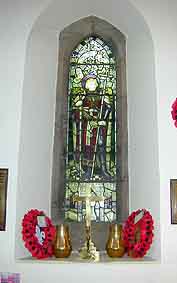
The window depicts Saint Alban, Britain�s first Christian martyr, who died in AD 304. This subject was probably chosen owing to the fact that the window was originally envisaged as a personal memorial to Theophilus Jones, Headmaster of Thringstone School (1913-14) who was killed during the German Bombardment of the Hartlepools, December 16 1914.
Mr Jones has his own unfortunate place in history as the first British soldier on active service to be killed on home soil in nearly two hundred years, and therefore the first such casualty of the Great War.
By the end of the First World War, a further twenty-six men from the Thringstone Parish had fallen, and it was decided to dedicate the window to their collective memory.
The names of the fallen are recorded on a brass tablet fixed by the window. A second tablet was added in 1948 to commemorate the four men from the Parish who lost their lives in the Second World War (1939-45). This tablet was unveiled by Captain W Bruce of The Meadows, Thringstone.
Also in the memorial window, brassware formerly placed on the altar �
Altar Cross � presented by Miss Imogen Booth and Miss Maud Saunders in 1910.
Candlesticks � brought to the church by the Revd LJ Chesterman in1955, from his previous parish of Hayling Island.
Two Vases - Inscribed to commemorate the fallen of the First and Second World Wars.
NORTH WALL (Continued) -
Banner of the Thringstone Branch of the Royal British Legion (next to the War Memorial Window), which was founded as a break-away group from the Whitwick Branch in the 1950s.
Millennium Tapestry
Banner made to celebrate the Millennium, consisting of church members� signatures, which were subsequently embroidered.
Plaque � List of Vicars
The wooden plaque, listing incumbents of the parish since 1876, was presented by Frank Buller Shrewsbury in 1959, in memory of his brother, Cheverton Shrewsbury, the second vicar.
Stained Window (Saint Mary of Bethany)

Made by Kempe of London, this window was installed in the easternmost lancet of the north wall in 1917 in memory of Mary Shrewsbury, the vicar�s first wife, who died suddenly in 1916. The window was the gift of the vicar.
SOUTH WALL
Vestibule
The oak vestibule over the South doorway was presented in 1972 in memory of Edward and Grace Hicken of Thringstone by their son and daughter.
A brass plaque fixed to the vestibule commemorates the installation of electric lighting in the church in 1932, at which time the original gas fittings were removed.
Stained Window (Madonna and Child)
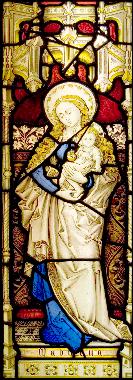
Set centrally in the westernmost lancet of the south wall (next to the porch), a salvaged panel presented in memory of Mrs Jean Sharpe (1943-2004), a dedicated member of Saint Andrew's Church, installed 2005. The panel is surmounted by roundels of contemporary glass and beneath the panel is a commeorative dedication. The glass is believed to date from circa 1870, possibly by James Powell. More research is needed in order to reveal the precise origins and history of the glass.
Stained Window (Saint Martha)

In the easternmost lancet of the south wall, this window is again by Kempe and presented in memory of Mary Shrewsbury (d.1916) This window was the gift of the congregation and parishioners, 1917, and cost �31 12s 6d.
CROSSING AND TRANSEPTS
The cross is 36 feet by 18 feet 6 inches.
At the end of each transept is a large three-light window, with lancet lights surmounted with a quatrefoil circle.
Choir Stalls
The choir stalls are original fittings, dating from 1862. Note the book rest of the rear stall on the north side � joins in the timber can be seen where once a harmonium was fitted. Apparently, this was brought over to the church every weekend from the National School and used until an organ was acquired in 1882.
ON THE NORTH SIDE �
Pulpit
The present pulpit is the third.
The original Victorian pulpit was sold for use in the chapel of Shelton Hospital, Shrewsbury in 1960, and replaced by one presented in memory of the Rev C Shrewsbury, second Vicar. This was destroyed by dry rot in 1980, and replaced by the pulpit we now see, presented in memory of Robert JH Maloney of Thringstone, a former footballer with Northampton Town, by his widow and daughter in 1982. This pulpit was made by Ronald Denys Lowe, a cousin of Mr Maloney.
Wooden Crucifix (formerly on Velvet Fall) � carved by Mr MB Maloney, Easter 1956
Pedestal Book Case � made and presented by Mr Maurice Robinson in 1973 to contain the Register of those interred in the Garden of Remembrance.
ON THE SOUTH SIDE �
Wooden Lectern � dating from 1873
Processional Cross � cast by Mr MB Maloney, 1963
Organ
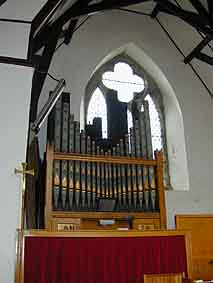
The organ (in the south transept) was made by S.Taylor and Co of Leicester in 1882, to the specifications of the first vicar at a cost of �100, being opened for use in January 1883. The organ was situated in the north transept, almost blocking the door to the vestry, until it was moved as part of chancel alterations, circa 1960.
The instrument was decorated in 1884, when the pipes were painted and mural representations of Saint David and Saint Cecilia were fixed on either side of the console. Note that Saint Cecilia�s keyboard is shown with far too many black keys, however.
Organ dismantled in 2008, after 125 years of service. Painted pipes and some of the casing retained and mounted on east wall of south transept as a display surround for new electronic organ.
Painting - On the west wall of the south transept, a large painting (acrylic on canvas) entitled, 'Thringstone At The Cross-Roads' by local artist Michael Statham MA, 2004 (pictured below, photograph courtesy of Geoff Walker).
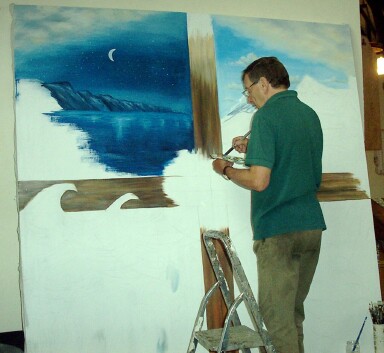

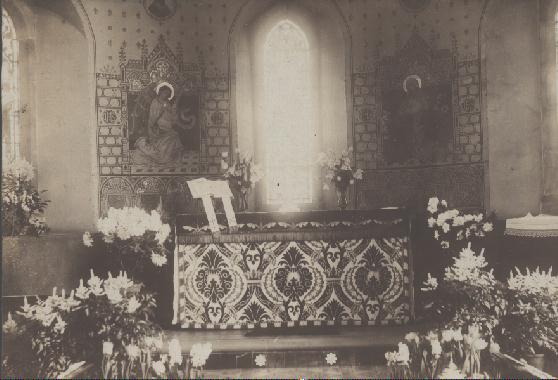
The Sanctuary measures 20 feet wide by 15 feet 6 inches and has a round ended apse.
The Sanctuary is raised up on three steps, and partitioned by a wooden altar rail. The apse contains three lancet windows, all of which were decorated with stained glass in 1881. The windows are by Mr FA Oldaker of Epsom and depict the figures of Christ the Good Shepherd in the central window, with those of St Peter and St Andrew in the side lights.
An encaustic tile floor was laid in the sanctuary in July 1882, though unfortunately this was removed a century later when a new asphalt floor was laid following the discovery of dry rot.
In 1883, the entire sanctuary wall was decorated with murals (images painted onto strips of zinc and canvas, which were then adhered to the wall). The main subject, and divided by the central window, was the Annunciation, with busts of the four evangelists placed in medallions at intervals around the top of the apse. These murals were removed in 1952, having deteriorated greatly with age.
Prayer Desk � presented by the family of the late Mr and Mrs Charles Jayes Gregory of Leicester in 1961
Vicar's Stall - Made in 1962 to compliment the Prayer Desk, this was built in Japanese Light Oak by Mr Marston of Bruntingthorpe at a cost of 15 pounds. The Revd R F Willis had briefly been Rector of Bruntingthorpe before coming to Thringstone.
Curate's Chair - presented by parishioners for use by the Revd John Bird, first ever curate of Thringstone Church - June 2003.
Litany Desk - donated anonymously in 1909, now used as prayer desk to Curate's Chair.
Silver Plated Altar Set (Cross and Candlesticks) � presented in memory of Charles Toon, a chorister for more than fifty years, in 1974.
Silver Alms Plate � presented for use at the altar in memory of Mr and Mrs Walter Watts by their daughter and her husband, Mr and Mrs JW Brooks in 1975.
Mothers Union Banner � presented by Miss HC Crane, a daughter of the first vicar, and dedicated by the Revd John O. Dasiewhare of Nigeria, December 1963.
Sunday School Banner- made by Mrs Zoe Hatton of Thringstone, 1957.
Credence Table � made and presented by Mr JT Belcher, a former sidesman, in 1958
VESTRY
A round-ended vestry is located at the north east end of the church containing one lancet window in the apse and a door allowing access to the church yard. The vestry measures 11 feet 6 inches by 8 feet 6 inches and is accessed internally from the north transept. The original entrance was through the sanctuary, and a deep recess can still be seen in the vestry wall where this was located until it was blocked off in 1882.
The vestry is used primarily for the robing of the choir.
CHURCH YARD
The churchyard was extended in 1910 by incorporating about half an acre of glebe on the north side. Prior to this time, there had been more than 900 burials in the old narrow churchyard, which had only been possible due to the practice of double interments.
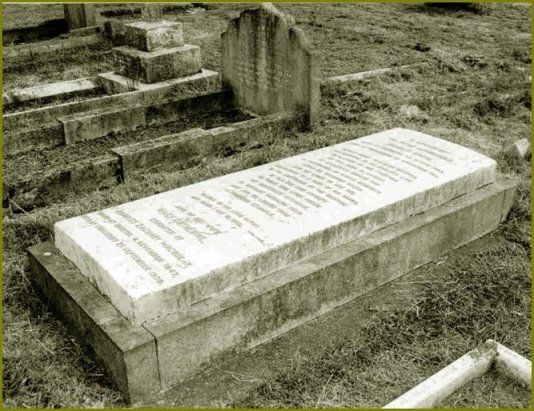
The village of Thringstone has a claim to fame in its association with the Rt Hon Charles Booth, PC (1840-1916) of Gracedieu Manor, the pioneer of old age pensions.
His tomb and beautiful epitaph can be found on the north side of the churchyard, close by the footpath, about twelve yards from the nave, and summarises the life work of one of England�s greatest philanthropists.
He is buried with his wife, Mary Catherine (1847-1939) of the distinguished Macaulay family.
The tomb is a low rectangular slab (ashlar) and has a slightly curving top set on a stepped base. It was designated a listed monument in 2002.
Colliery Fatalities
Ongoing research by Ron Goacher of Thringstone has so far revealed that the churchyard contains the graves of at least 23 men and boys who lost their lives in the local coal mining industry. Three of these were victims of the Whitwick Colliery Disaster, 1898.
Garden of Remembrance (Cremations)
This was laid out by Mr W Willmott and first used in 1971.
Heating Chamber
Located next to the north transept wall is a deep excavation, covered over with concrete lintels. This was dug to accommodate a boiler for the new heating system, which was installed in 1914, when pipes and radiators were fixed inside the building.
During the incumbency of the Rev LJ Chesterman, new overhead electric heating was introduced in the church and the boiler-house was later filled in with waste.
In 1980, the chamber was re-excavated when water was discovered seeping into the foundations of the transept. The excavation revealed that much of the filling was contaminated with dry rot and that the chamber had also been subject to a large passage of water. An automatic extraction pump was subsequently installed. According to tradition, a natural watercourse passes under the churchyard at some depth, emanating from Gracedieu Wood and which is discharged into the Thringstone Brook at the back of Glebe Farm.
Back to St Andrews Homepage